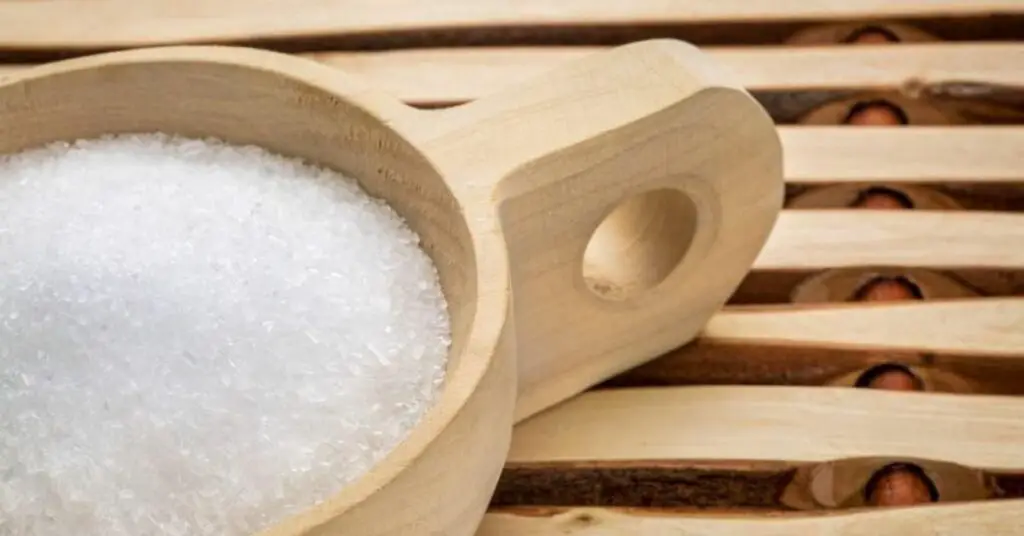Using Epsom salt in a jetted tub also known as Jacuzzi tub might sound like a good idea, but many people have reported that this can cause damage to the jets and the tub itself.
Find out if you Can Use Epsom salt in a Jetted Tub in this article.
Use the links below for easy navigation
What is Epsom Salt?
How to Use Epsom Salt in a Jetted Tub?
How to Clean a Jetted Tub after Epsom Salt bath?
What are the benefits of using Epsom Salt in jetted tub?
Can you use Epsom Salt in chlorinated water?
Final Thoughts
What is Epsom Salt?

Epsom salt is a mineral compound comprised of magnesium sulfate. Magnesium sulfate can help to soothe muscle aches and pains. Additionally, Epsom salt can help to detoxify the body by drawing out toxins through the skin. For these reasons, many people ask if they can use Epsom salt in a jetted tub? And the answer is yes! It can be used for some great benefits but there are a few limitations.
Related: Feel weird after epsom salt bath
How to Use Epsom Salt in a Jetted Tub? (Jacuzzi tub)
Epsom salt is made from minerals from an ancient sea bed and while it’s commonly used as a bath salt, its uses go far beyond that. Here we will discuss how to use Epsom salt in your jetted tub and what to keep in mind while doing it.
Related: How does a jetted tub works
Step 1:
The first thing you need to do is fill up your tub with hot water. You want it hot enough that it feels like it’s going to burn you, but not so hot that it burns your skin or makes you feel uncomfortable.
Step 2:
Once it’s full, add 1-2 cups of Epsom salt to the water. The amount of salt you need depends on the size and shape of your tub; if yours is small, maybe just one cup will do; if it’s large, maybe three cups will suffice.
Step 3:
Let the salt dissolve in the water for about five minutes. You don’t want any big chunks floating around—they’ll make a mess by clogging up the jets—so just let them dissolve completely.
Step 4:
Then activate the jets by turning them on with a little bit of pressure from your hand or foot (don’t use too much force or else they may break). They should start working within a few seconds after activating them!
Step 5:
Soak in the tub for as long as you want.
Step 6:
After you’re done soaking in the tub, turn off the jets and take a hot shower so there’s no epsom salt left on your body.
Step 7:
Apply a moisturizer to your body so your skin is not dry.
Step 8:
Wrap a robe or towel around your body to make sure your muscles don’t catch a chill.
Related: Most comfortable bathtub shapes
How to Clean a Jetted Tub after Epsom Salt bath?
After your Epsom salt bath, it’s important to drain the tub. This will help reduce the risk of mold and mildew growth in your tub. If you leave too much water in the tub after a bath, it can cause mold and mildew to grow on the walls of the tub.
First, drain the tub. You want to make sure it’s completely empty so you don’t leave any dirt or debris behind when you rinse it out.
Then, carefully rinse the sides of the tub with water and make sure to clean each individual jet carefully. Spray water on the jets of your tub and clean them as well. This will help remove any residue from your Epsom salt bath and make sure that nothing gets stuck in there.
Make sure there are no water stains on the bottom of your tub or floor before you turn off the faucet.
Finally, let your tub air dry completely.
Helpful Tip: Take a normal bath after every four or five Epsom salt baths to wash off any soap residue left behind.
Related: How to turn on jacuzzi tub
What are the benefits of using Epsom Salt in jetted tub?

Jetted tubs have become a popular way to relax and unwind with friends and family. But did you know that using Epsom Salt in your jetted tub can also help improve your health?
Let’s take a look at the benefits of using Epsom salt in jetted tub
Natural Occurring Mineral
Epsom salt is a naturally occurring mineral compound found in hot springs, which are located all over our planet. It’s been used for thousands of years as a treatment for various ailments, and it has been used in bathtubs and jets ever since.
Excellent Detoxifier
Because Epsom Salt contains magnesium sulfate which binds with water molecules resulting in an alkaline pH (7-8), it’s considered an excellent detoxifier when added into baths or showers where there are high levels of chlorine present due to tap water!
Related: Baking Soda in Bath Water
Soothing Agent
Epsom salt is known as a “soothing agent,” which means that it helps calm your body down and reduce stress levels. It also enhances mood by boosting serotonin levels in the brain. You’ll feel more confident and happy after using this product!
Related: One piece bathtub shower combo
Respiratory Ailment
Epsom salt can help with muscle aches, joint pain, sore muscles—the list goes on and on. It has been used since ancient times to treat respiratory ailments like asthma and bronchitis as well as digestive issues like constipation or diarrhea due to its ability to reduce inflammation within the body’s tissues.
Removes Pollutants
The best part? Epsom salt removes pollutants from your body while also moisturizing the skin. It’s not just great for relaxation; it’s also great for detoxifying!
Related: Best 2 person jacuzzi tub
Can you use Epsom salt in chlorinated water?
If you’re going to use Epsom salt in chlorinated water, be aware that it can cause damage to your skin and tub.
Epsom salt is made up of magnesium and sulfate. When used in the water, Epsom salt will dissolve into the water and begin to neutralize the acidity of the chlorine. The result is an alkaline solution with a pH of 9 or higher. This can be dangerous if you’re using it in a tub full of chlorinated water because it will increase the acidity of your skin and tub, which could result in burns or other injuries.
According to the Environmental Working Group (EWG), using epsom salts that contain chlorine can cause “irritation to eyes, nose, and throat.”
So if you’re going to use epsom salts in a pool or spa setting, make sure they don’t contain any chlorine. Otherwise, avoid using them at home unless you want to risk damaging your skin and lungs!
What can you not put in a jetted tub?
You should avoid rose petals, carrier oils, bubble baths, and colorants in jetted tubs. While all of these things are great for you to use in your bathtub, they can cause several problems for your jetted tub.
Rose petals are highly abrasive and can wear away at the surface of your tub.
Carrier oils will leave a layer on the bottom of your tub that will eventually have to be removed with chemicals or scrubbing. This can lead to discoloration or damage to your tub.
Bubble bath contains alcohol which can damage tiles and liners over time. A bubble bath also contains foam which can clog jets and filters in your tub.
Colorants are not only irritating to sensitive skin but they also interfere with the way the water flows through the jets so it no longer feels like a relaxing soak should!
Can you use oils in a jetted tub?
No you cannot use oils in a jetted tub as they can clog the jets and damage the pumping system. Instead, you can use bath salts, or other similar products designed for use in jetted tubs. Always refer to the manufacturer’s instructions and guidelines before using any product in a jetted tub.
Final Thoughts
Epsom salt can be added to the water in a jetted tub, and it’s completely safe to use with your tub. In fact, if you want to add Epsom salt to your tub, you’ll get the relaxing results.


